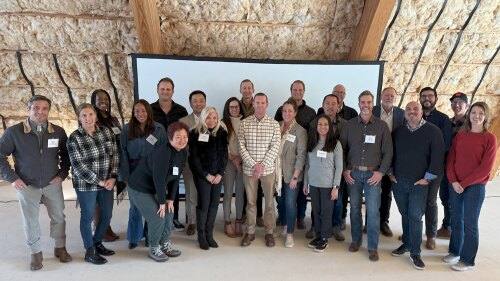Despite recent moves by the Trump administration to dismantle regulations aimed at cutting carbon emissions and slowing the pace of climate change, ULI remains committed to the practice of sustainable real estate development, says Patrick L. Phillips, ULI global chief executive officer. The reason? Because the momentum behind consumer demand and capital markets that favor high-performing real estate assets that are resource efficient and environmentally sustainable shows no sign of slowing down.
“We have felt that there is a consensus among industry participants that we don’t expect a rollback or retreat from the practice of sustainable development,” Phillips said during a members-only webinar held earlier this month. “Real estate operates in a competitive marketplace both for capital and for tenants. The tenant demand, market demand, as well as the providers of capital—the enablers of real estate development—are squarely supportive of enhanced sustainability, energy efficiency, and the like.”
In addition, real estate is an industry that is regulated largely at the state and local level, and “there’s no evidence of a broad-scale retreat at that level,” Phillips observed. “While there may be changes in funding streams, . . . or in the establishment of common standards across governmental jurisdictions, there doesn’t seem to be any retreat from the basic idea that we can do better.”
Given the market’s confidence in and commitment to sustainable real estate practices, ULI is sharpening the focus of its own Center for Sustainability. What began as the Climate, Land Use, and Energy (CLUE) initiative has evolved into the Center for Sustainability and Economic Performance, which houses the Greenprint Center for Building Performance, the Urban Resilience Program, the Tenant Energy Optimization Program, and now the Building Healthy Places Initiative.
Former ULI global chair Lynn Thurber chaired an advisory group whose role has been to identify a new strategic direction for the center. That aim will be “zeroing in on the business cases for sustainability,” Phillips said. “It really is about the dollars and cents of sustainability.”
Phillips noted that sustainability is a crowded field with thought leadership from myriad organizations—public, private, and nonprofit alike—competing for the attention of the real estate community. ULI can differentiate itself by providing tools and strategies for measuring environmental performance and by investing in technologies that can ultimately be used to create value in a single property as well as across an entire investment portfolio.
“ULI’s distinctive expertise and voice focus on the enhancement of value through investment in sustainability measures,” Phillips explained. “We’re defining the business case to include different dimensions: informing project strategy; defining approaches for execution and innovation in planning and design, construction, operations; finding more competitive market position; mitigating risks; and improving access to capital.”
Two examples of ULI tools that yield actionable insights to help owners, investors, and tenants reduce energy consumption and generate returns are the Greenprint Center for Building Performance and the Tenant Energy Optimization Program (TEOP), an initiative launched at the 2016 Fall Meeting in Dallas.
Founded in 2009, the Greenprint Center provides its members with an environmental management platform where they collect, analyze, and benchmark resource consumption and carbon emissions data for their properties. The Greenprint portfolio comprises more than 5,400 commercial buildings, representing more than 1.3 billion square feet (121 million sq m) of space in nearly 40 countries.
The center, which has as its goal cutting carbon emissions from member properties by 50 percent by 2030, tracks progress toward that goal in its annual Greenprint Performance Report. Over the past six years, Greenprint members have cut energy consumption by 13.7 percent, greenhouse gas emissions by 16.5 percent, and water use by 10.9 percent; this year alone, members saved $42 million in utility costs. Greenprint recently added 2 billion square feet (186 million sq m) of commercial office space to its portfolio through a partnership with Measurabl, a provider of sustainability software for the real estate industry. Measurabl subscribers will now be part of the Greenprint portfolio.
On the webinar, Charles Leitner, Greenprint chairman and ULI global trustee, emphasized the need for tools such as the Greenprint environmental management platform—which can guide decision makers through actionable building performance data—to transform the market so that sustainable practices are considered a core competency rather than a niche investment strategy.
“We’ve achieved a lot of progress but maybe not yet have reached the tipping point in the market to where we’ve achieved market transformation,” said Leitner, chief executive officer of the Boston-based Berkshire Group, a multifamily investment firm. “It takes capital flows to drive market transformation, and the connectivity between capital decision making, investment decision making, and long-term environmental practices is key.”
Among those large-scale, forward-thinking institutional investors that have long been committed to sustainable real estate is the California Public Employees’ Retirement System (CalPERS), a $300 billion pension fund with a 10 percent allocation to real estate. All portfolio managers in its real estate unit belong to Greenprint and use the energy management platform to track building performance data for the CalPERS portfolio. The data also serve as a basis for evaluating the investment decision making of the managers themselves, said webinar panelist Eric Schlenker, portfolio manager at CalPERS.
“We really rely on the data, not just as a basis of comparison but improvement,” Schlenker said. “We can look year-over-year at performance and how our assets compare to those across the greater portfolios of members in the Greenprint space. It allows us to have a foundation for a dialogue with managers and an objective way to assess building performance.”
While buildings account for 40 percent of greenhouse gas emissions globally, tenants account for 50 percent of those buildings’ emissions. How tenant spaces are designed and constructed is critical to improving energy and resource efficiencies buildingwide. The latest Greenprint Performance Report identified tenant engagement as the next frontier in sustainable real estate.
An effort to address that, TEOP is a ten-step process through which tenants design their spaces to maximize energy efficiencies and cost savings. Companies that have engaged the TEOP process have realized an energy savings of 25 to 30 percent and, on average, a 25 percent internal rate on return.
“These practices translate into value, real dollars,” Schlenker said. “The tenants in these buildings tend to be stickier, vacancy loss is reduced, costs are reduced. The smart way to take our portfolio—a core, stabilized income–generating portfolio—is by reducing risk and volatilities within those cash flows.”





